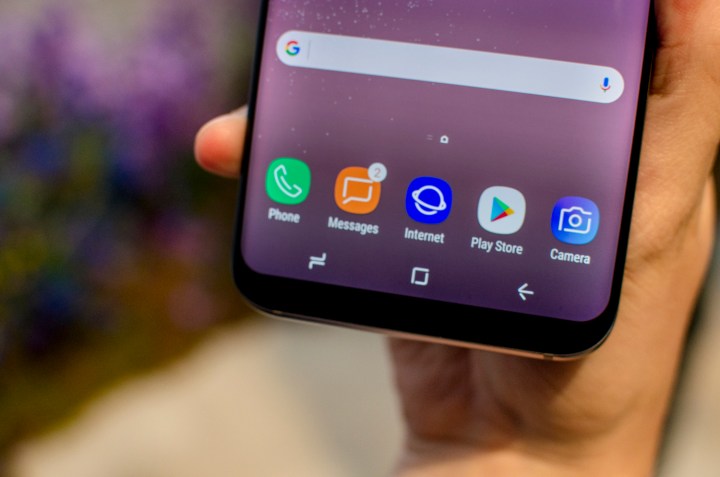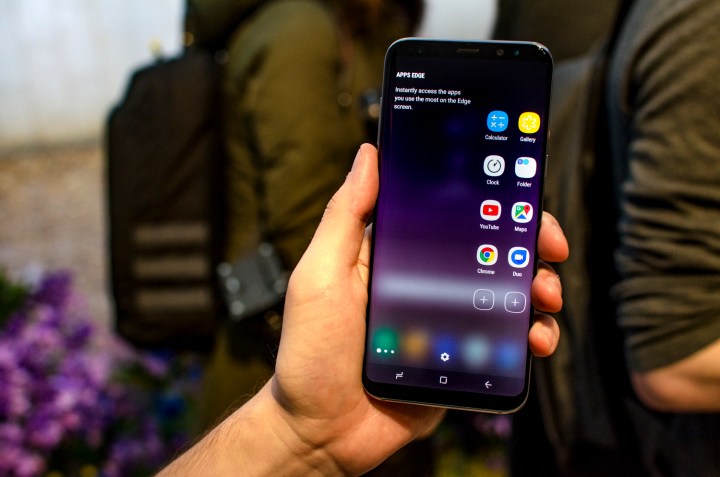
Specs
|
|
|
|
| Size | 159.5 x 73.4 x 8.1 mm (6.28 x 2.89 x 0.32 in) | 149 x 72 x 7.62 mm (5.85 x 2.85 x 0.30 in) |
| Weight | 6.1 ounces (173 grams) | 5.54 ounces (157 grams) |
| Screen | 6.2-inch Quad HD+ Super AMOLED | 5.5-inch Quad HD Super AMOLED |
| Resolution | 2,960 x 1,440 pixels (529ppi) | 2,560×1,440 pixels (534ppi) |
| OS | Android 7.0 Nougat | |
| Storage | 64GB | 32/64GB |
| SD Card Slot | Yes | Yes |
| NFC support | Yes | Yes |
| Processor | Qualcomm Snapdragon 835 (U.S.) Samsung Exynos 8895 (International) |
Qualcomm Snapdragon 820 (U.S.) Samsung Exynos 8890 (International) |
| RAM | 4GB | 4GB |
| Connectivity | Wi-Fi, 4G LTE, GSM, CDMA, HSPA+ | Wi-Fi, 4G LTE, GSM, CDMA, HSPA+ |
| Camera | Front 8MP, Rear 12MP with OIS | Front 5MP, Rear 12MP with OIS |
| Video | 2,160p 4K |
2,160p |
| Bluetooth | Yes, version 5.0 | Yes, version 4.2 |
| Fingerprint sensor | Yes | Yes |
| Other sensors | Barometer, gyroscope, accelerometer, compass, heart rate, proximity sensor, iris scanner | Barometer, gyroscope, accelerometer, compass, heart rate, proximity sensor |
| Water Resistant | Yes, IP68 | Yes, IP68 |
| Battery | 3,500mAh | 3,600mAh |
| Charger | USB Type-C | Micro USB |
| Quick Charging | Yes | Yes |
| Wireless Charging | Yes, Qi and PMA | Yes, Qi and PMA |
| Marketplace | Google Play Store | Google Play Store |
| Color offerings | Black, silver, orchid gray, coral blue (international), gold (international) | Black, white, gold, silver |
| Availability | AT&T, Verizon, Sprint, T-Mobile | AT&T, Verizon, Sprint, T-Mobile |
| DT Review | 4 out of 5 stars | 4 out of 5 stars |
The world of smartphones is always moving forward, and newer is generally better in the performance department. That’s certainly the case with the
Winner:
Design, display, and durability

Clearly, the S8 Plus represents the pinnacle of Samsung’s design journey over the last few years. It’s a beautifully curved wonder of glass and metal with an impressively big screen. The South Korean manufacturer has been consistently producing some of the best-looking phones on the planet. We fell in love with the S7 Edge, but by squeezing down the bezels and losing the home button on the front, Samsung has managed to turn out something even more gorgeous.
From behind, there isn’t much to separate them, but from the front, the S8 Plus wins all day long. We have some usability concerns about the fingerprint sensor on the back of the S8 Plus, right next to the camera module, but Samsung has mitigated that issue by including iris scanning and facial recognition as alternative unlock methods.
If you’ve been hankering for an all-screen design, the S8 Plus and its smaller sibling look to be about as close as anyone has gotten. The S8 Plus packs a 6.2-inch screen into an impossibly svelte body. Sure, it’s a touch taller, wider, and thicker than the S7 Edge, but look at the extra real estate you get. The S7 Edge screen is just 5.5 inches. Don’t get us wrong: The S7 Edge is one of the best smartphone designs we’ve ever seen and both employ the same vibrant, Super AMOLED technology, with very little difference in terms of resolution, but the S8 Plus is more refined.
Because of the curves and the glass back, both the S8 Plus and the S7 Edge are easy to damage if dropped and expensive to fix. Neither phone is likely to survive a drop unscathed (the S8 Plus even more so), but they can cope with water. The IP68 rating means they can be submerged in up to 5 feet for water for half an hour without sustaining damage.
Winner:
Battery life and charging
There isn’t much to choose between the S8 Plus and S7 Edge when it comes to battery size. Somewhat surprisingly, the S8 Plus has a slightly smaller 3,500mAh battery, compared to the S7 Edge’s 3,600mAh, but the newer processor should make it more efficient. On the other hand, the S8 Plus does have a bigger screen to power and that’s always the main drain on battery life. We’ll have to test the new phone out as a daily driver for a few days before we can make a proper call on battery life, but it doesn’t look like there will be a great deal of difference between these two. Our S7 Edge needs a charge every day and we expect the S8 Plus to be the same.
Both support a choice of fast wired charging or wireless charging via the Qi and PMA standards. The S8 Plus is capable of charging slightly faster than the S7 Edge, especially thanks to the USB Type-C port, but again we’ll have to test and see which is better to claim a winner here.
Winner: Draw
Camera

The main cameras in the S7 Edge and S8 Plus appear to be identical. They’re both rated at 12-megapixels and excel at taking low light photos. All the extras you’d expect are here, including optical image stabilization, phase detection autofocus, and
Winner:
Software

Since they’re from the same manufacturer you might expect the S8 Plus and S7 Edge to offer a very similar user experience, but Samsung has added some extras to the newer
Nougat offers Google Assistant on board, but Samsung has developed its own artificial intelligence called Bixby, which even has a dedicated hardware key. We’ll need to get a closer look at that before we can say whether it’s a killer feature, but it’s something the S7 Edge doesn’t have. We would also expect the S8 Plus to continue to receive updates for a little longer than the S7 Edge, so it scores a win here.
Winner:
Price and availability
You can buy the Galaxy S7 Edge from all major carriers and a range of retailers. Since it has been available for a year now, the price of the S7 Edge has started to fall. You can pick one up unlocked for around $500 to $700 depending where you shop. If you’re willing to sign up to a two-year contract, then you can snag one for less than $30 per month with no money down. The S8 Plus is available to pre-order now and will be released on April 21 in the U.S. It’s going to cost you $850 unlocked or around $35 per month on a two-year contract with no money down.
| Samsung Galaxy S8 Plus | Samsung Galaxy S7 Edge | |
| AT&T | $850 or $28.34 per month for 30 months | $695 or $20.63 per month for 30 months |
| Sprint | $850 or $35.42 per month for 24 months | $695 or $28.96 per month for 24 months |
| T-Mobile | $850 or $30 per month for 24 months with a $130 down payment | $600 or $25 per month for 24 months |
| Verizon | $840 or $35 per month for 24 months | $696 or $29 per month for 24 months |
The S7 Edge is quite a bit cheaper and more widely available for the moment, so it wins this round.
Winner: Galaxy S7 Edge
Overall winner: Galaxy S8 Plus
You are always going to pay a premium for the latest and greatest tech, but there’s little doubt that the S8 Plus improves on the S7 Edge in a few ways. Most prominent is the new design, the faster processor, and the improved front-facing camera. However, the differences are far from major and the S7 Edge is still an excellent phone that’s now significantly cheaper. If you already have an S7 Edge, it’s going to be tough to justify an upgrade to the S8 Plus. But, if you’re buying right now, and you just want the best phone, then it has to be the S8 Plus.
Editors' Recommendations
- Best Samsung Galaxy S22 deals: Save big on unlocked models
- Best Samsung Galaxy S24 deals: Save up to $800 on the phone
- The best Samsung Galaxy S23 Plus cases in 2024: the 17 best ones
- Samsung is fixing an annoying display issue on the Galaxy S24
- The best Samsung phones in 2024: our 8 favorite Galaxy handsets




